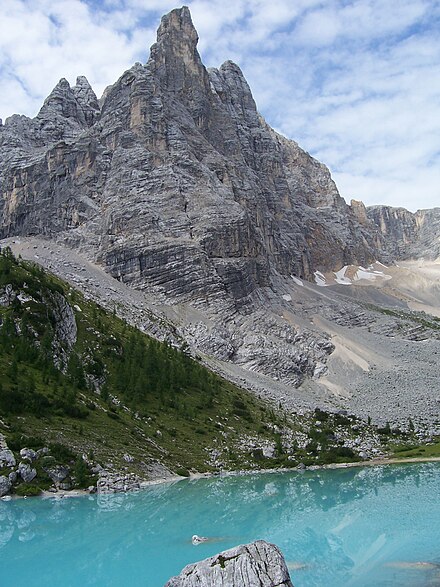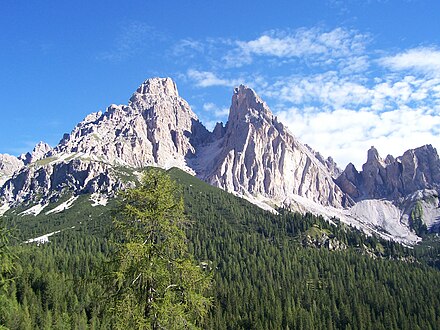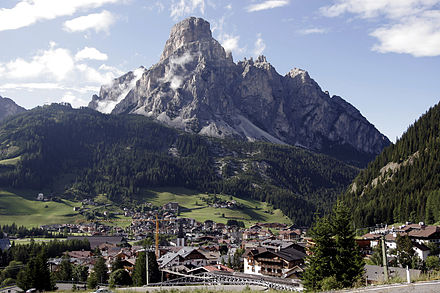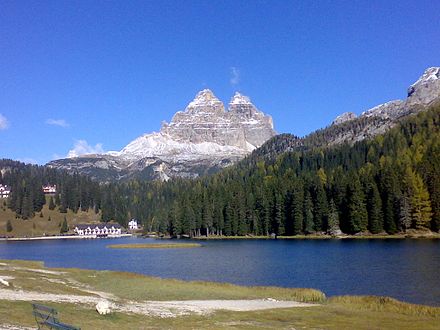Cortina d'Ampezzo is a ski resort in the province of Belluno in northeastern Italy, near the Austrian border. It hosted the Winter Olympics in 1956, and will team with Milan to host the 2026 Winter Games.
Understand
 The most famous, fashionable and expensive Italian ski resort, Cortina is nicknamed la Regina delle Dolomiti - the Queen of the Dolomites. It's in the middle of the Conca d'Ampezzo, a glacial trough in the high Boite Valley. Cortina is visited by all types of travellers from the jet set to normal families both during the winter and the summer, and even in summer, you may well find all camp sites full.
The most famous, fashionable and expensive Italian ski resort, Cortina is nicknamed la Regina delle Dolomiti - the Queen of the Dolomites. It's in the middle of the Conca d'Ampezzo, a glacial trough in the high Boite Valley. Cortina is visited by all types of travellers from the jet set to normal families both during the winter and the summer, and even in summer, you may well find all camp sites full.
History
The town was part of the Venetian Republic, administratively part of Cadore, from 1420 until 1511 when the Austrians invaded the region during the War of the League of Cambrai. With a few breaks, the region remained part of Tyrol County until WWI, though the majority wasn't German speaking but spoke Ladin.
In the late 19th century, Cortina first became a center for mountaineering for the wealthy, with the first luxurious hotels being built, and in 1903 a ski school opened making it a winter resort also. The First World War halted the development; the region became a battle ground between Austria-Hungary and Italy and at the end of the war it became part of Italy. International skiing competitions were held here in 1932 and 1941, and after the Second World War Cortina recovered rapidly to become the big international ski resort it's today. In 1956 the town hosted the Winter Olympics, and is scheduled to do so again in 2026 (together with Milan).
Climate
Cortina's climate is something between the oceanic, subalpine climate typical to the Alps near the Adriatic Sea and the continental climate in the inner Alps. Yearly precipitation is about 1100 mm measured in water. The rainiest months are June and July and the driest is February. In late December and early January the region (especially at the Cimabanche pass between the Belluno and Bolzano provinces) often experiences the coldest temperatures in Italy. Shoulder seasons are usually wet and rainy, cold and very windy.
Tourist information
- Infopoint Cortina, Corso Italia, 81, 46.53782°, 12.13614°, +39 0436 869086, infopoint@cortinadolomiti.eu.
Get in

By plane
Cortina has a heliport and nearby Bolzano has flights from a couple of German destinations. Flying in you'd want to fly to the Venice Area, either Venice Marco Polo Airport (IATA: VCE) 160 km away, Treviso 130 km, or Innsbruck (Austria) 170 km away.
By car
Driving in is the most obvious option. Cortina is not too far from the Autobahn from the Brenner Pass; exit the autostrada A22 at Bressanone/Brixen and take the SS49 to Dobbiaco/Toblach and SS51 to Cortina. From Verona you can do the same, as the smaller roads going to Cortina as the crow flies don't seem to be accessible from the autostrada north of Bolzano and they're mostly made up of hairpin curves anyways. From the southeast comes the autostrada A27 that goes from Venice to Cadore some 40 km away from Cortina, from there, follow SS51.
Thankfully the valley does not have a very high elevation so it is clear of treacherous road conditions for much of the year, be sure to check road conditions before driving and be aware that conditions tend to be far worse through the mountain passes, be sure you are driving on the most traveled passes as they get cleared first.
By train
Once there was a train service to Cortina, though it was shut down in 1964. The closest train stations nowadays are in Calalzo 35 km to the south and in Toblach 31 km to the north. Calalzo has train services from Venice, which in turn can be reached from Milan, Rome and other major Italian cities. Local trains between Lienz in Austria (trains from for example Vienna, Klagenfurt and Villach) and Franzensfeste (on the line between Innsbruck and Bolzano) stop at Toblach.
-
Calalzo-Pieve Cadore-Cortina railway station (Stazione di Calalzo - Pieve Cadore - Cortina), 46.44391°, 12.38862°. There is a train to Pieve Di Cadore some 35 km from Cortina that comes direct from Venice (€7.50 each way) a 6 times a day during the peak winter season and takes approximately 2h45m. Dolomiti Bus runs a bus that runs roughly 5-10 min after arrival that will go to go to Cortina in approx a half hour, a ticket is €3 and can be purchased upon entering. Taxis to Cortina from here are €65. Similar public transport runs in summer.
-
Toblach railway station (Stazione di Dobbiaco), 46.72478°, 12.22551°. Station 31 km north of Cortina, connected to it by buses operated by SAD
By bus
Buses run from Venice, operated by ATVO and Cortina Express, the latter also has services from as far as Bologna and several places in the Dolomites. Dolomiti bus also has local services. You'll have to check the timetable as the frequency and schedule changes frequently.
Get around
Based on convenience and the cost of a taxi, you are best advised to bring a car. However, for many that will not be possible so buses are the next best option.
By foot
Walking within the town is the obvious option, as it is relatively compact.
There are many and varied hiking routes, reached by buses, cable cars, gondolas or chair lifts, or on foot. Good maps are available, especially one at 1:25000, which have all the routes marked complete with their relevant numbering (which corresponds to the numbering on the actual paths themselves. The Tourist Office has also a rather basic map which is also useful for orientation purposes. For the most part the routes are well marked in the usual red-white-red flashes common in many parts of the Alps.
One local bus goes up to the Auronzo hutte/rifugio/mountain inn, which sits directly beside the Tre Cime de Lavaredo, one of the finest mountain blocks in the Dolomites. From the refugio you can walk on a fairly level path anti-clockwise around the mountain, to get the very best views from the far side.
By public transportation
There are local public buses, operated by Se.Am., the small orange ones which will take you in the very immediate vicinity. Connections with Dolomitibus at the bus station will take you to the surrounding towns and outlying areas, as well as to the ski areas, but do so rather infrequently. Skibuses do not run from 10am to 2pm, and stop at 5pm. The Dolomiti buses are very useful for hikers as they mostly go west and east to the mountain passes, from which cable cars or chair lifts ascend, and bus stops are often positioned at the starting points for hikes. Timetables for all these services are available in the bus station. Combination tickets are available for both buses and lifts and represent a good saving if you plan to be around for several days.
By taxi
Taxis are generally available and can be called, some areas have a taxi stand like the bus station, or Passo di Falzarego. Taxis are very expensive in Cortina, expect to pay €3 per kilometer and they typically charge from Cortina to where they are picking you up and then to your destination. I.e a trip from Pocol ski lifts to Cortina an 8 km trip will cost €30.
By car
During the winter a lot of visitors not only arrive by car but use them get around in town meaning congestion is frequent. In the summer on the other hand a lot of people get in and around by bike meaning there may be a lot of bikers moving slowly uphill the roads.
Car rentals are available in Cortina, also with driver.
Parking areas
- Via dello Stadio, 46.54172°, 12.13292°.
- Via Marconi, 46.53904°, 12.13832°.
- Via Lungo Boite, 46.53764°, 12.13370°.
- Via del Parco, 46.53569°, 12.13599°.
- Via dei Campi, 46.53356°, 12.13642°.
See
In town
- Mario Rimoldi Museum of Modern Art (Museo d'arte moderna Mario Rimoldi), Corso Italia, 69, 46.537045°, 12.137498°, +39 0436 2206, museo@regole.it. Modern art museum in the Ciaṣa de ra Regoles building.
- Rinaldo Zardini Paleontological Museum (Museo Paleontologico Rinaldo Zardini), via Marangoi 1 - loc. Pontechiesa (Centro Culturale Alexander Girardi Hall), 46.54001°, 12.13144°, +39 0436 875502, museo@regole.it. This museum displays the largest collections of fossiles from the Dolomites.
- Basilica of Saints Filippo and Giacomo (Basilica dei Santi Filippo e Giacomo), Corso Italia, 88, 46.53730°, 12.13658°. Built in 1769-1775 on the place where two earlier churches have stood.
- San Francesco Church (Chiesa di San Francesco), 46.53639°, 12.13768°. From the late 14th century.
Outside town

-
Parco naturale regionale delle Dolomiti d'Ampezzo, 46.595278°, 12.105556°, +39 0436 2206, info@dolomitiparco.com.
-
Cinque Torri, 46.51016°, 12.052065°. The "five towers" is a fine group of extraordinarily shaped mountain stumps in a more or less straight line so that from a distance they may be thought to resemble a row of towers. It's frequented by alpinists and climbers thanks to many climbing routes of different difficulty levels. A chair lift makes this superb viewpoint accessible to anybody, though only climbers can enjoy some of the attractions. Right beside the Cinque Torre, some World War 1 trenches, shelters and gun positions have been well restored and you can walk around these safely, reliving those times with the help of information boards which carry photographs, explanatory text and maps.
-
Sorapiss Lake (Lago di Sorapiss), 46.52055°, 12.22351°. Pretty lake with turquoise waters with the mountain group with the same name mirrored in it. You can get there in two ways: drive to Passo Tre Croci and walk along path nr. 215 for 6 km (2 hours, with an altitude gain of 200 m), or walk from Cortina 15 km (4 hours). There's a guesthouse where you can eat and sleep. For seasoned hikers there's a relatively challenging path (Giro del Sorapiss) including vie ferrate circulating the lake along mountain sides, this trek takes two days.
-
Pocol military cemetery (Sacrario militare di Pocol), 46.52717°, 12.1169°. The final resting place for 9707 Italian and a number of Austro-Hungarian soldiers fallen in WWI battles.
-
Zenna Fortification (Castello de Zanna), Via del Castello, 159, Majon, 46.54665°, 12.13277°. The ruins of a small white fortification, now immersed into the surrounding landscape amongst modern houses.
-
Sant'Antonio di Padova church (Chiesa di Sant'Antonio di Padova), Chiave village, 46.55338°, 12.13500°.
-
Marmolada mountain massif, 46.4463°, 11.8683°. 2016/10/19
Do
During the summer the main draw is hiking in the surrounding mountains. There are many different trails, easier and more demanding ones. In the winter Cortina offers all kinds of winter sports from skiing and snowboarding to curling and ice hockey - both as activities and spectator sports. The town isn't all about sports; there are also different cultural festivals and markets.
Winter

You have a choice of 2 cable cars from the town, and the bus to the other areas in the Cortina Ski Region:
- Tofana. By the Ice Arena on the north end of town, which services Tofana area which is the highest elevation and usually has the best conditions 2019-07-01
- Faloria, 46.5481°, 12.1949°. And one by the bus station on the south end of town that can access Faloria and Cristallo. 2019-07-01
Alpine skiing
There are three skiing areas around town: Ski Area Faloria Cristallo Mietres, Ski Area Tofana and Ski Area Lagazuoi 5 Torri. These have 66 pistes of different difficulty levels with a total length of about 120 km. You can use the Dolomiti Superski pass here, a pass allowing access to 12 ski resorts around the Dolomites with a total of 450 pistes and a length of over 1200 km.
-
Ski Area Faloria Cristallo Mietres, 46.53859°, 12.13055°. 24 pistes (5 black, 11 red, 8 blue) with a total length of 44 km. The Vitelli piste in Faloria is one of the most scenic in the Dolomites. Cristallo features the Staunies piste, reputed as the most technical and difficult in the Dolomites with a steepness of 63%! The Mietres area, in turn, is suitable for beginners and children.
-
Ski Area Tofana, 46.54578°, 12.13135°. 37 pistes (6 black, 12 red, 13 blue and 6 green) with a length of 47 km. The Cortina competition in the Women's Skiing World Cup takes place on the Canalone and Schuss pistes. In the lower parts there are pistes for beginners and a freestyle skiing area. Skiing experts, on the other hand, can try out the black-rated Vertigine Biance piste. The pistes of the 1956 Winter Olympics can be walked by tour. In the Ra Valles area you can take the Freccia nel Cielo cable car up to an altitude of 2500 m above sea level for fabulous views over the landscape.
-
Ski Area Lagazuoi 5 Torri, 46.52993°, 12.01024°. 11 pistes (5 red, 6 blue) with a length of 29 km. This area is connected to the Passo Falzarego area as well. From here you can take the cable car to Rifugio Lagazuoi to admire the views of the mountains Marmolada, the Sella group, Civetta, Pelmo and Tofane.
Cross-country skiing
Cross-country skiing is also possible. There are many skiing tracks in the Parco Naturale delle Dolomiti d'Ampezzo. Enthusiastic skiers can purchase the Dolomiti NordicSki pass to access about 1300 km of tracks.
Skiing school
- Boarderline, Via XXIX Maggio, 13/b, 46.53807°, 12.13837°, +39 0436 878261, scuola@boarderline.it. M-S 8:30-12:30, 15:30-19:30. Skiing and snowboarding school with a shop selling clothes and mountaineering equipment.
Other winter sports
There are places for skating, curling, go kart on snow, snowmobiling and sledding.
- Stadio Olimpico, Via Bonacossa, 1, 46.54440°, 12.13311°, +39 0436 881812. The Olympic Stadium hosts hockey games, skating and musical events. Free Wi-Fi.
Summer

Like the winter, the summer season is also about the outdoors and sports. Hikers can choose between flat paths and climbing vie ferrate to heights. While Cortina is a very popular hiking destination, other options include tennis, golf, sport fishing and biking.
- Cortina Golf, Loc.Fraina, 14/15, 46.52610°, 12.14537°, +39 0436 860952, info@cortinagolf.it. 18 hole golf course next to the Miramonti Majestic hotel.
- Parco Avventura Adrenalin Center, Località Ronco, 46.54234°, 12.12621°, +39 335 8155177, cortina@adrenalincenter.it. Adventure tracks for both adults and children with zip lining, rope bridges and the like.
- Tennis Club Cortina, Località Sopiazes, 46.54356°, 12.12994°, +39 0436 868486, info@tenniscortina.it. Six tennis courts (three with red earth and three with astroturf, one of the latter is covered), and a soccer field. There's a tennis school with courses and private lessons. The place hosts an ATP Challenger tournament and a VIP tournament.
- Gruppo Guide Alpine Scuola d'Alpinismo, Corso Italia, 69/a, 46.53693°, 12.13725°, +39 0436 868505, info@guidecortina.com. Mountaineering school where you can learn different techniques: alpinism, ski-alpinism, rock climbing and using vie ferrate.
- Klettersteige Cortina d'Ampezzo.
Around the year
- Public library (Biblioteca civica), Corso Italia, 83, 46.53786°, 12.13628°, +39 0436 861353.
Events
Upcoming events are listed here.
- Cortina InConTra, +39 0436 868061. summer and winter edition. Stage discussions about current economical, political and cultural issues.
- Cortinametraggio, +39 0402464384, info@cortinametraggio.it. mid-March. Film festival with short films, trailers, web series and Instagram videos. Free entry to Cinema Eden during the festival.
- Coppa d'oro delle Dolomiti, +39 331 3855236, info@coppadorodelledolomiti.it. Annual vintage car race.
- Una Montagna di Libri - Estate, info@unamontagnadilibri.it. "A mountain of books" is a book festival going on the whole summer. You can meet Italian authors in town during the event. This time of the year authors are awarded the Premio Cortina d’Ampezzo and Premio della Montagna Cortina d’Ampezzo prizes.
- Tour de Ski. Annual cross-country skiing competition.
- Lavaredo Ultra Trail. Internationally known ultra foot race with different difficulty classes.
Buy
Local specialties include majolica stoves, iron, copper and glass objects, mosaics, wooden sculptures and professional photographs.
-
Corso Italia, 46.53826°, 12.13579°. The main street is the beating heart of the town with much of the commercial activity including artisan boutiques.
-
La Cooperativa di Cortina, Corso Italia, 40, 46.53696°, 12.13861°, +39 0436 861245, info@coopcortina.com. The largest shopping mall in the region, frequented by locals and tourists alike with different businesses from bookshops to bars and supermarkets to art shops.
-
Rizzati, Via Cesare Battisti, 39, 46.53889°, 12.13458°, +39 370 3431960. Chocolate shop.
Eat
The local cuisine is not too different from the one in Tyrol and Western Austria, and many dishes are known by the German names. Italians describe it as "poor in appearance but rich in taste and tradition".
A signature appetizer is chenedi, bread dumplings filled with meat, spinach or cheese, not unlike German knödels, that are served in a hot broth or with butter. Others include casunziei, ravioli or potatoes filled with beetroots and spiced with butter and poppy seeds, and perstarei, dough pieces boiled in salty milk (traditionally eaten for breakfast). Dishes from the Venetian times include cortina polenta, rise e bise (rice and peas) and faariesa (bean soup). Austrian rule brought in the Hungarian goulash soup.
Main dishes include roast meat with mushrooms, gröstl (meat with spätzle noodles, with Austrian origins), different game stews and a range of sausages mostly served with potatoes. There are also a range of dairy products.
Common desserts are apple cake (in practice the German apfelstrudel), ricotta cake, krapfen (fried sweed buns), nighele (small donuts without filling) and the Austrian sachertorte. There are also many variants locally produced berry jams and honey, that could also make for nice souvenirs.
Budget
- Area 51, Località Acquabona di Sotto, 46.50614°, 12.15905°, +39 331 2282323.
- Hacker Pschorr Haus, Via Stazione, 7 (Vicino al fruttivendolo nel collegamento tra Largo Poste e Corso Italia (di fronte al bar Cristallino)), 46.53838°, 12.13603°, +39 0436 867625. Beer hall serving simpler meals.
Mid-range
-
Ristorante il Campanile, loc. Fraina 14/15 (presso il golf club), 46.52313°, 12.15177°, +39 333 1020638, ristilcampanile@gmail.com. The restaurant of the golf club serving local cuisine
-
Ristorante Ra Stua, Via P. Grohmann, 2, 46.53984°, 12.13431°, +39 0436 868341, ristoranterastua1@libero.it. Historical restaurant, Belluno cuisine.
-
Ristorante Il Vizietto di Cortina, Via Cesare Battisti, 64/A, 46.538750°, 12.134329°, +39 0436 860789.
-
5 Torri, Largo delle Poste, 13, 46.53874°, 12.13615°, +39 0436 866301, info@ristorante5torri.it.
-
El Camineto Meloncino, Località Rumerlo, 1, 46.537460°, 12.104364°, +39 0436 4432. 2018-01-29
Splurge
- Baita Piè Tofana, Località Rumerlo, 46.54096°, 12.09903°, +39 0436 4258. Traditional dishes, fantastic views.
- Ristorante Al Camin, Località Alverà, 99 (Sulla strada che porta al passo Tre Croci e a Misurina.), 46.544343°, 12.150853°, +39 0436 862010, info@ristorantealcamin.it.
- Ristorante Tivoli, Lacedel 34 (località Lacedel), 46.533496°, 12.121837°, +39 0436 866400, info@ristorantetivoli.it. One of the finest restaurants in town.
Drink
In high season (August, December and January) there's a wide selection of nightlife for different audiences. The main nightclub is the VIP club with a restaurant and a discotheque, though younger people prefer smaller clubs.
For a glass before of after dinner, people mostly head to LP26 (also known as La Prosciutteria in Largo Poste) and Bar Sport, both on Corso Italia.
-
Bar Pasticceria Embassy, Corso Italia, 44, 46.53699°, 12.13821°, +39 0436 863777.
-
Bar Sport, Corso Italia, 132, 46.53854°, 12.13560°, +39 0436 868444.
-
VIP Club, Corso Italia, 207 (piano terra dell'Hotel Europa), 46.54138°, 12.13506°, +39 0436 3221.
-
LP26 (La Prosciutteria), Largo delle Poste, 26, 46.53806°, 12.13768°, +39 0436 862284, dokcortina@dallava.com. Part of a chain, but a popular place with locals.
Sleep
Cortina d'Ampezzo is a popular destination, despite being expensive especially when it comes to lodging.
Budget
-
Free parking for campervans, Via dei Campi, 82 (space for 70 vehicles), 46.53336°, 12.13641°.
-
Rifugio Alfonso Vandelli, 46.521684°, 12.226624°, +39 0435 39015. Inn at Lake Sorapiss, 150 m from the lake with 57 places to sleep. Also has a restaurant.
Mid-range
-
Faloria Mountain Spa Resort, Zuel di Sopra, 46, 46.5148°, 12.1455°, +39 0436 2959. A four star hotel. Presents 31 suites and several services. Rates starting from €130. Breakfast and wellness centre included.
-
Hotel Alaska, Largo delle Poste, 39, 46.53885°, 12.13716°, +39 0436 868539. Four star hotel with restaurant.
-
Sporting Hotel Villa Blu Cortina, Loc. Verocai, 73, 46.54692°, 12.13706°, +39 0436 867541. Four star hotel with restaurant.
-
Hotel Al Larin, Località La Vera, 13, 46.55515°, 12.12880°, +39 0436 861341, info@hotelallarin.com.
-
Hotel Regina, Via Castello, 1, 46.53991°, 12.13455°, +39 0436 2797, info@hotelreginacortina.com.
-
Hotel de la Poste, Piazza Roma, 14, 46.53794°, 12.13586°, +39 0436 4271, info@delaposte.it. Historical hotel.
Splurge
-
Hotel Cortina, Corso Italia 92 (center), 46.53753°, 12.13700°, +39 0436 4221, info@hotelcortina.com. Check-in: 14:00, check-out: 12:00. One of the oldest hotels in Cortina, with nonsmoking rooms. Free Wi-Fi and private parking, pets allowed, luggage storage available. €146+
-
Hotel Cristallo Palace, via Menardi, 42, 46.53305°, 12.14622°, +39 0436 881111. Five star hotel, probably the most luxurious in town.
-
Grand Hotel Miramonti Majestic, via Peziè, 103, 46.52145°, 12.14398°, +39 0436 4201. Historical hotel, rates five stars next to the golf course.
-
Hotel Europa, Corso Italia 207, 46.51438°, 12.13501°, +39 0436 3221, info@hoteleuropacortina.it.
Stay safe
There aren't any bigger safety issues.
- Carabinieri, Via Guide Alpine, 14, 46.53283°, 12.13862°, +39 0436 882000.
- Municipal police (Polizia Municipale), Viale Marconi, 3/a, 46.53906°, 12.13754°, +39 0436 866666, polizialocale@comunecortinadampezzo.bl.it.
- Fire brigade (Vigili del Fuoco), Via delle Guide Alpine, 12, 46.53312°, 12.13916°, +39 0436 5722.
- Guardia di Finanza, Via IV Novembre, 21/b, 46.54682°, 12.13501°, +39 0436 2943.
Stay healthy
- Cortina hospital (Ospedale di Cortina), Via Codivilla, 1, 46.55510°, 12.13258°, +39 0436 883111.
Pharmacies
- Farmacia, Corso Italia, 25, 46.53654°, 12.13907°, +39 0436 2609.
- Farmacia, Corso Italia, 236, 46.54166°, 12.13556°, +39 0436 861313.
- Farmacia, Corso Italia, 151, 46.54692°, 12.13396°, +39 0436 2223.
Contact
- Poste Italiane, Largo Poste 18/A, 46.53839°, 12.13691°, +39 0436 882411.
There's a free Wi-Fi area (connessione free) in town.
Go next


- Tofane
- Alleghe
- Corvara
- Val di Zoldo
- Lago di Misurina
- Auronzo di Cadore and Tre Cime di Lavaredo
- Tre Sassi military forts (Forte militare Tre Sassi) - An Austro-Hungarian fort built in 1897 in the Valparola pass.
- Castello di Botestagno - The ruins of a medieval castle in the hamlet of Prà de Castel.
- Belluno Dolomites National Park (Parco nazionale delle Dolomiti Bellunesi)
- Ampezzo Dolomites Regional Nature Park (Parco naturale regionale delle Dolomiti d'Ampezzo)

